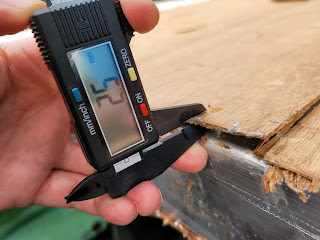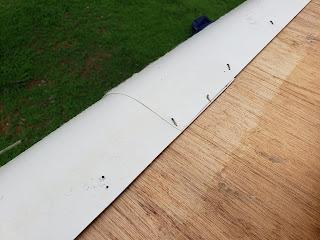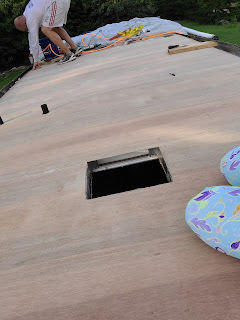RV Roof Replacement
PART 3: Removal of old TPO membrane and assessment of damage
On this day our plan was to remove the TPO membrane, find out which areas needed to be removed (hopefully not many), and then simply replace those boards with new ones. It was a simple plan. One we thought would only take a few hours.
Oh, no. After we peeled back the membrane we were horrified to discover that Coachmen factory installed 1/8" lauan plywood as the roofing material (shame on you!). On the various DIY sites and videos from professional roof installers we watched it was recommended that the roofing be NO LESS than 1/4", with a desired thickness of 3/8" so it was absolutely horrifying to see how thin the material was.
 |
| This is the thickness of our factory-installed roof. Yikes! |
For the most part, an RV roof is comprised of several layers: the interior layer which is usually a thin piece of plywood, Styrofoam or other insulation nestled in between your joists (ours were 6ft apart...), and finally another layer of plywood which is what your roofing membrane is adhered to. The outermost part of our roof didn't even measure 1/8"- it was actually only 2.5mm thick. This is barely thicker than cardboard, so you can imagine the strength the roof of our camper had with this material being placed on top of joists that were 6 feet apart. I am shocked we were even able to walk on it without falling through to be honest.
 |
| Peeling back the membrane to reveal the damage underneath |
 |
| Damage to the rear driver's side |
 |
Water damage to the front corners
|
 |
| Severely rusted screws that attached our ladder to the roof |
 |
| Water damage to the rear passenger's side |
Anyway, to add to our problems we also discovered that the lauan was attached to the Styrofoam below with industrial adhesive. This meant that we would literally have to chisel the damaged boards away from the Styrofoam so as not to damage it. Luckily, there wasn't *that* much damage to the roof. We actually kind of laughed because it we went through a whole lot of drama for just a few minor-ish spots. In hindsight, the areas that were soft were actually a result of the embarrassingly thin layer of plywood that comprised the roof and not necessarily rotten wood. However, the damage that we did see would have surely turned into a much bigger problem had we not addressed it.
 |
| Chiseling away the damaged wood from the Styrofoam insulation |
I DO want to give a HUGE shout-out for Azdel siding. If you have an RV, you know that one of the biggest problems you can have is delamination of your fiberglass walls. Azdel claims to be a revolutionary new product that does NOT delaminate or mold, and I can personally tell you that that claim is true. If you look at this photo, you will see what it looks like when the roof is removed, exposing the exterior walls and roof. The roof material has started to dry rot and separate in layers, but the Azdel looks almost new. I was truly completely blown away by this sight. If we had regular fiberglass, with the amount of water that our camper was exposed to we would have most certainly have delamination. From now on, if I ever buy again I will absolutely make sure it is one that uses this product.
 |
| Azdel siding on a dry-rotted roof |
We also discovered the source of the RV leak- a tiny curved plastic piece that served as a junction between the rear termination bar and the vertical bars that go up either side of the rear of the RV. This piece was not only cracked, but the part that gets screwed onto the bar was also broken, so it wasn't able to securely hold the bar in place on the RV, causing it to stick out. The previous owners (or perhaps even the dealer that sold it to them) put on extra lap sealant but it still did not fix this problem. Water was able to leak in through the cracks of this piece with ease. Unfortunately, we discovered that there was no way to replace this essential piece- it was not sold anywhere. Fortunately, I have a very resourceful dad who used a type of resin putty that he used to attach to the piece and mold into a replica of the original. He even drilled a hole in it and painted it to match the RV. What a guy!
 |
Behold, the culprit of the leak (the undamaged piece). A MAJOR design flaw, IMO
|
Before removing the membrane, we needed to remove the radius trim that ran along the side of the camper. This was achieved by using a screwdriver and a hammer to pop out the staples that were holding it in place.
 |
| The trim whose purpose is to soften the edges between the roof and side of the camper |
Removal of the TPO membrane was also a difficult job. We found that slicing small pieces of membrane made removal easier. It took several hours of pulling and a lot of blisters but we got it done. It was unfortunate that the original TPO membrane was fleece-backed, as removal left behind a layer of fuzz that we were worried would interfere with the adhesion of the new membrane to the roof.
 |
| Membrane removed from roof |
 |
| This was not an easy job! |
We went back and forth whether to just replace the damaged wood with another layer of 1/8" plywood and leave the rest as is, making the roof 1/8" or add an additional layer of 1/8" plywood overtop the old undamaged to make the roof 1/4". The former was definitely the easier option, but one we felt uneasy with. After weighing our options we decided to do the right thing: we would make the entire roof 1/4" It wasn't the ideal 3/8", but definitely a LOT better than what was on it.
 |
| Damaged wood successfully removed from Styrofoam insulation |
Read on for Part 4, which is installation of the new roofing!
























































